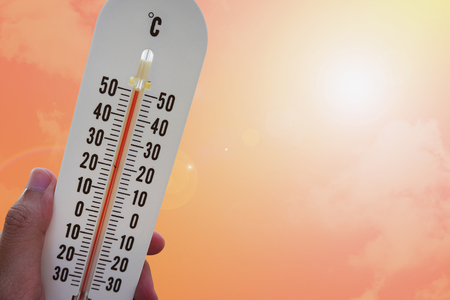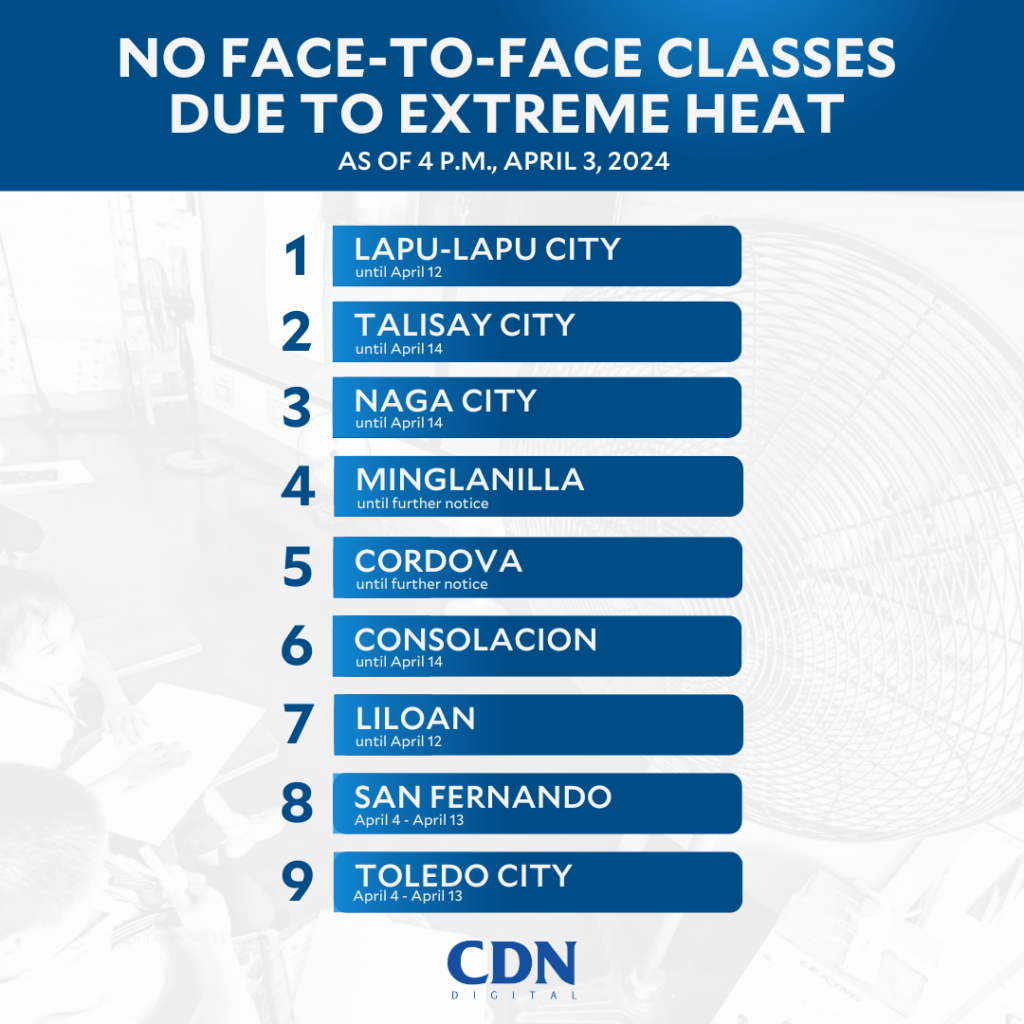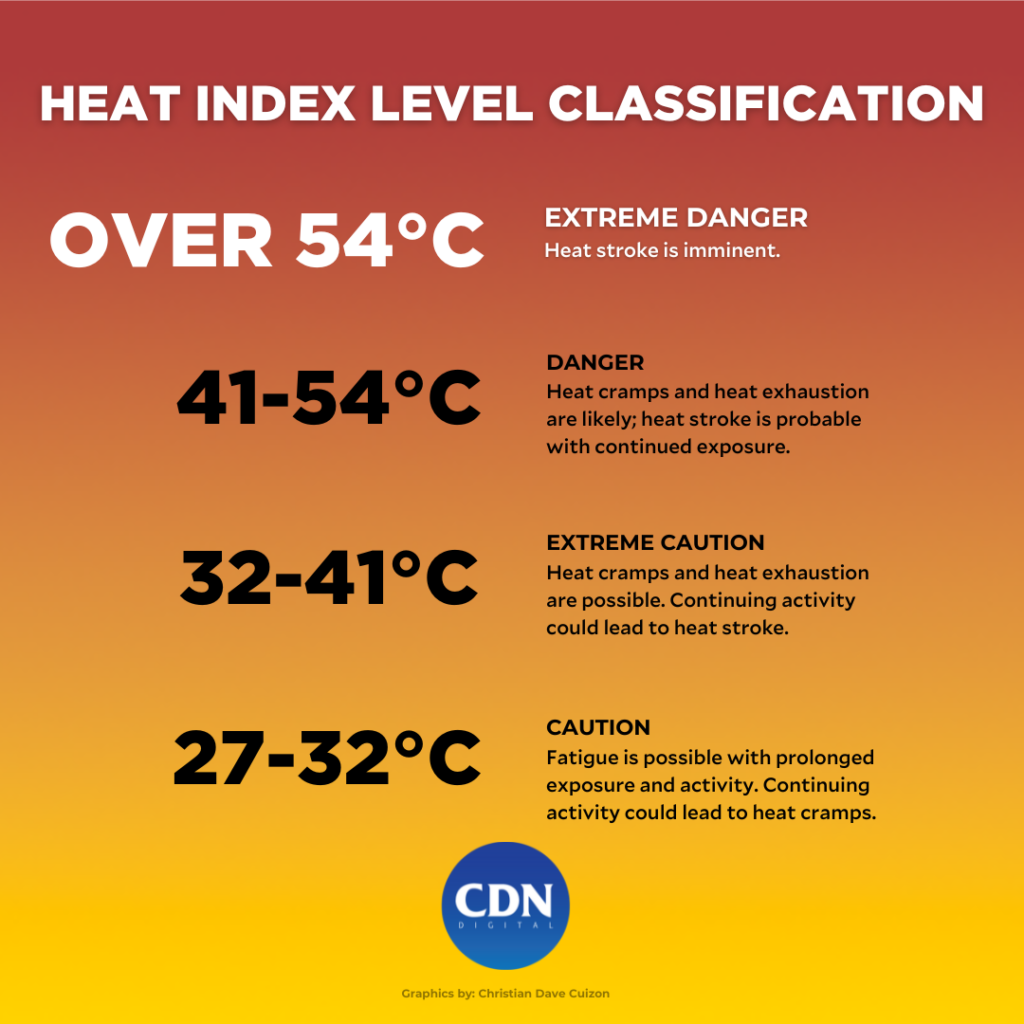EXPLAINER: Why do we monitor the heat index?
CEBU CITY, Philippines – Once again, students and teachers in Cebu had to return to alternative modes of learning, like online classes and modular types, this summer.
Face-to-face classes in several localities here have been suspended but for a different reason. This time, it’s because the heat has become unbearable and risky for both teachers and learners.
As of April 3, seven areas in Cebu already allowed schools to shift to pandemic-era, blended learning due to extreme heat.
This is the first time in Cebu’s recent history that local governments had to suspend face-to-face classes due to intense heat.
Since summer – or the dry, hot season – began, the heat index in Cebu has reached dangerous levels, with days reaching up to 38 degrees Celsius.
A heat index of 38 degrees Celsius falls in the ‘extreme caution’ category of the state weather bureau’s heat index classification.
This means prolonged exposure can lead to heat cramps, heat stroke, dehydration, and possibly – heat stroke.
But what is the heat index? And why do authorities monitor them, and use them as basis for several decisions, like canceling face-to-face classes?
READ: Extreme Heat as a ‘New Pandemic’: Thousands in PH Cancel Classes During ‘Hottest Year’
READ: Scorching schools: How heat worsens conditions of poor students in PH
What is heat index?
Heat index, according to Engr. Al Quiblat, chief of the Visayas radar of the Philippine Atmospheric Geophysical and Astronomical Services Administration (Pagasa), is the temperature people feel.
It combines air temperature with relative humidity. It is also why it’s often referred to as ‘temperature apparent’.
“Kung sa Tagalog, damang init. Ug kung sa Bisaya pa, ang init nga mabati,” said Quiblat in an interview with CDN Digital.
When coming up with a heat index forecast, Pagasa uses a three-tiered system that utilizes current and present data related to air temperature and relative humidity, as well as a meteorologist’s interpretation.
“Di ni siya tagna-tagna lang. Di ni kay igo ra mi mutudlo sa gawas og muingon ‘mao ni ang heat index karung adlawa’,” Quiblat said.
Effects on the human body
In addition, experts use heat index temperatures when gauging the climate’s impact on the human body.
Pagasa has its own heat index classification system that serves as an overall guide for the public when monitoring the heat index.
Patterned from the National Oceanic and Atmospheric Administration (NOAA) from the United States, it divides critical, heat index temperatures into four levels.
These are the caution, extreme caution, danger, and extreme danger.
When heat index temperatures hit 27 degrees Celsius, people should take the necessary measures to prevent heat-related illnesses like heat cramps, exhaustion, and dehydration.
Heat-related illnesses may manifest in various ways. The usual symptoms involved sweating profusely; experiencing fatigue, dizziness, light-headedness, or blacking out; having a weak but fast pulse; nausea; and in some cases – vomiting.
In fact, a person must not stay under the sun, unprotected, for more than 20 minutes to avoid falling ill, Quiblat pointed out.
If left unaddressed, heat cramps, exhaustion, and dehydration can be fatal and may lead to heat stroke, the Department of Health (DOH) stated.
“Most commonly, heat stroke often occurs as a progression from milder heat-related illnesses such as cramps, syncope, and exhaustion,” the DOH said.
Heat index temperatures beyond 54 degrees Celsius meant heat stroke was imminent.
Last April 2, a 58-year-old man from Brgy. Kamputhaw, Cebu City collapsed and then died while walking along Escario Street. He was believed to have suffered from heat stroke.
READ MORE: Man, 58, dies of ‘heat stroke’ in Brgy. Kamputhaw, Cebu City
Here in the Philippines, there is no specific data yet pointing to heat stroke mortalities.
At risk
Heat stroke and other heat-related illnesses can affect anyone. But DOH pointed out that those at risk are people who are more than 50 years old and children.
Children, in particular, are known to have a lesser capacity to regulate body temperature than adults, based on existing studies.
When kids are exposed to unbearable hot weather for long periods, they are likely to suffer from heat-related illnesses.
By 2050, around 33 million children in the Philippines will be exposed to heat waves due to global warming, according to projections from the United Nations International Children’s Emergency Fund (UNICEF).
This means that less than 30 years from now, at least 8 out of 10 Filipino kids will suffer from high heat waves.
Prevention
People cannot escape extreme heat but there are multiple ways to prevent heat-related illnesses, including heat stroke.
- Avoid prolonged exposure to the sun.
- As much as possible, do not go outdoors.
- Avoid consuming diuretics such as coffee, tea, and carbonated drinks as these may lead to further dehydration.
- Instead, drink plenty of water and stay hydrated.
- Wear bright-colored clothes when going out.
Disclaimer: The comments uploaded on this site do not necessarily represent or reflect the views of management and owner of Cebudailynews. We reserve the right to exclude comments that we deem to be inconsistent with our editorial standards.



